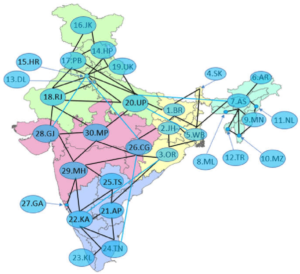Posted on Posted in ELECTRICAL TECHNOLOGY
The electrical power network of India is a vast and complex infrastructure that encompasses generation, transmission, and distribution of electricity across the country. Here’s a broad overview:
- Generation:

- India has a diverse mix of power generation sources including coal, natural gas, hydroelectric, nuclear, wind, and solar.
- Coal-based Power Plants: These are the dominant source of electricity generation in India, accounting for a significant portion of the total installed capacity.
- Renewable Energy: India has been increasingly focusing on renewable energy sources like solar and wind to reduce dependency on fossil fuels and mitigate environmental impact.
- Hydroelectric Power Plants: India has several large and small hydroelectric power plants, especially in regions with high rainfall or mountainous terrain.
- Transmission:

- Electricity generated at power plants is transmitted through a network of high-voltage transmission lines. The Power Grid Corporation of India Limited (POWERGRID) is the central transmission utility responsible for interstate transmission of electricity.
- Regional transmission utilities are responsible for intra-state transmission.
- Distribution:

- At the distribution level, electricity is supplied to consumers through a network of distribution lines, substations, and transformers.
- State Electricity Boards (SEBs) or State Power Utilities (SPUs) are responsible for electricity distribution within their respective states.
- Private distribution companies also operate in some states.
- Interconnections:

- India has interconnected regional grids: the Northern, Eastern, Western, and Southern Grids. These grids allow for the transfer of electricity between regions to ensure stability and reliability of supply.
- The Unified Power Market (UPM) facilitates trading of electricity between different regions.
- Smart Grid Initiatives:
- India is gradually adopting smart grid technologies to improve efficiency, reliability, and sustainability of the power network. This includes advanced metering infrastructure, distribution automation, and demand response systems.

- India is gradually adopting smart grid technologies to improve efficiency, reliability, and sustainability of the power network. This includes advanced metering infrastructure, distribution automation, and demand response systems.
- Rural Electrification:
- The government has been undertaking initiatives like the Deen Dayal Upadhyaya Gram Jyoti Yojana (DDUGJY) and the Saubhagya scheme to enhance electricity access in rural areas and provide 24×7 power supply to all households.
- Challenges and Opportunities:
- India’s power sector faces challenges such as inadequate infrastructure, transmission losses, financial viability of distribution companies, and environmental concerns.
- However, there are also opportunities for growth and innovation, particularly in renewable energy development, energy efficiency measures, and integration of advanced technologies into the power grid.
Overall, the electrical power network of India is undergoing significant transformation driven by technological advancements, policy reforms, and evolving energy needs.
POWER NETWORK OF INDIA

